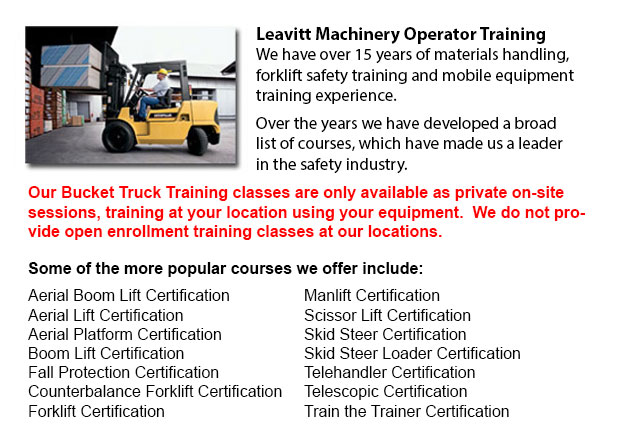
London Bucket Truck Training - The Vehicle-Mounted Aerial Work Platform or bucket truck training program is designed to decrease the risk of personal injury and incident while working in close proximity or with bucket trucks by efficiently training qualified operators. An aerial lift device refers to whatever vehicle-mounted device, telescoping or articulating, or both, that is used to position personnel to reach spots which would otherwise be inaccessible. Aerial lift devices are made use of to elevate personnel to above-ground work locations.
The program aims to provide operators with the knowledge, skills, training materials and abilities required in order to safely and efficiently operate vehicle-mounted aerial work platforms.
The program has two components: a classroom training session and a hands-on training session. In order to become certified, participants should be successful in both components. A wallet-size certificate and a full-size certificate would be issued upon finishing the program.
Types of lifts include articulating boom platforms, extensible boom platforms, vertical towers, aerial ladders and aerial ladder trucks and any combination of these devices. Aerial lift devices are normally made of wood, metal, fiberglass, reinforced plastic or other materials.
Definitions
Articulating boom platform: multiple hinged boom components.
Extensible boom platform: has either an extensible boom or a telescopic boom.
Platform: the part of an aerial device which is designed to carry employees.
Mobile unit: any aerial device together with its parts such as vehicle and related equipment.
Employers have the responsibility to ensure their worker get correct training prior to operating aerial devices. Employees should make sure they likewise acquire the needed training and that they do not operate lift devices if they are not authorized to do so. Employees should make certain that they have on the right protective equipment while working from the platform.
Course content includes operating the vehicle-mounted aerial work platform, safe operating practices, pre-shift inspections, use of emergency controls, lifting capacity, and administering theory and practical tests. Operators will become familiar with legal requirements under the local and federal regulations.
-
London Crane License
London Crane License - Crane operators ought to be "credentialed", that means they must possess a crane operator license or certification. Credentialing is considered a mandatory governmental requirement in order to practice as a crane operator. Obta... More -
London Heavy Equipment Operator Training
London Heavy Equipment Operator Training - Training facilities which offer quality standards in the industry and not just provide field performing tasks but added equipment training are highly sought after. Accredited schools provide students the kno... More -
Telehandler Training in London
Telescopic handlers usually referred to as telehandlers for short, are a very popular piece of heavy construction machinery. They are usually utilized in the agriculture and construction industries. These machines have maximum reaching capacity and c... More -
London Boom Lift Certification
London Boom Lift Certification - Elevated work platforms allow maintenance operations and work to be carried out at heights which could not be reached by any other means. Workers utilizing boom lifts and scissor lifts can learn how to safely operate... More -
London Fall Protection Ticket
London Fall Protection Ticket - Fall-related accidents are the number one reason of death within the construction industry. The potential for fall incidents really increases based upon the kind of work that is being completed within your workplace. T... More -
London Forklift Safety Training
London Forklift Safety Training - Anybody who wants to operate a lift truck should take a forklift safety training program to become a certified forklift truck operator. There are several ways to obtain forklift training. Programs are provided throug... More -
Operator Safety Training, Re-Qualification Training, In-House Instructor Training in London
Lift trucks are used in nearly all warehouse operations and in boat yards and in industrial construction sites. The reach feature of a forklift is a vital component used in various applications like for instance whenever a shelving system is being us... More -
London Boom Lift Safety Training
London Boom Lift Safey Training - Boom lifts are a type of elevated work platform or aerial lifting device that are commonly utilized in construction, industry, and warehousing. Boom lifts can be used in practically any surroundings due to their vers... More

Forklift Certification London
TOLL FREE: 1-888-254-6157
London, Ontario
forkliftcertificationlondon.com
Email Us
About Us


